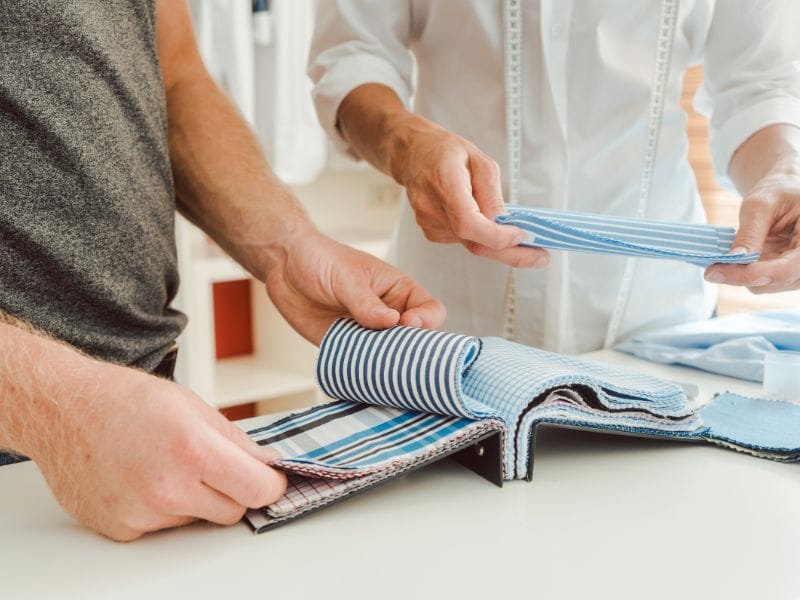When it comes to creating custom apparel, fabric choice is one of the most important decisions you’ll make. The type of fabric you choose not only impacts the look and feel of the garment but also its durability, comfort, and compatibility with various printing techniques. Selecting the right fabric can make all the difference in the quality and longevity of your custom clothing, whether it’s for corporate uniforms, promotional giveaways, or everyday wear.
In this blog, we’ll explore different types of fabrics used in custom apparel, the benefits of each, and how to choose the best one for your specific needs.
Why Fabric Choice Matters in Custom Apparel
Fabric affects nearly every aspect of custom apparel, from comfort and durability to how well it holds up under different printing methods. The right fabric enhances the look and feel of the final product and ensures that your design remains vibrant and intact. Here are some key factors impacted by fabric choice:
- Comfort: Some fabrics are more breathable and soft, making them ideal for all-day wear, while others provide warmth or stretch for different applications.
- Durability: High-quality fabrics withstand washing and wear over time, preserving both the garment and the printed design.
- Print Quality: Different fabrics work better with certain printing techniques, ensuring a clean, vibrant finish.
- Purpose: The intended use of the apparel should guide fabric choice, as corporate uniforms, activewear, and promotional items have different requirements.
Common Fabrics for Custom Apparel
1. Cotton: The Classic Choice
Cotton is one of the most widely used fabrics for custom apparel, especially for T-shirts. It’s known for its softness, breathability, and versatility, making it comfortable for all-day wear. Cotton also works exceptionally well with various printing techniques like screen printing, direct-to-garment (DTG) printing, and embroidery.
- Pros: Soft, breathable, and comfortable. Works well with most printing methods.
- Cons: Tends to shrink if not pre-shrunk; less durable than synthetic fibers.
- Best For: Everyday T-shirts, corporate uniforms, and casual wear.
2. Polyester: Durable and Moisture-Wicking
Polyester is a synthetic fabric that is highly durable and resistant to shrinking and stretching. It also wicks moisture away from the body, making it an ideal choice for activewear and uniforms. Polyester pairs well with sublimation printing, which allows for vibrant, all-over designs that won’t fade or crack over time.
- Pros: Durable, moisture-wicking, resists shrinking and fading.
- Cons: Less breathable than cotton; may feel less soft.
- Best For: Sports uniforms, activewear, and items with vibrant, all-over prints.
3. Cotton-Polyester Blends: The Best of Both Worlds
Cotton-polyester blends combine the comfort of cotton with the durability of polyester. This blend is a popular choice for custom apparel as it balances softness and durability, making it ideal for everyday wear. The fabric works well with most printing techniques and is less prone to shrinking or fading.
- Pros: Soft, durable, and resistant to shrinking and fading.
- Cons: May not be as breathable as 100% cotton; feel may vary depending on blend ratio.
- Best For: Versatile for T-shirts, hoodies, and promotional apparel.
4. Tri-Blend: For Softness and Style
Tri-blend fabrics typically consist of cotton, polyester, and rayon, creating an ultra-soft and slightly textured fabric. Tri-blends are lightweight, comfortable, and offer a unique look that’s popular in fashion-forward custom apparel. They work well with vintage-style or distressed prints.
- Pros: Ultra-soft, lightweight, stylish texture.
- Cons: More delicate; may be prone to pilling with heavy wear.
- Best For: Fashion apparel, casual wear, and stylish promotional items.
5. Fleece: Cozy and Warm
Fleece is a thicker fabric often used in hoodies, sweatshirts, and winter gear. It provides excellent warmth and is very durable, making it a favorite for cold-weather apparel. Fleece works well with embroidery, giving custom hoodies and sweatshirts a premium feel.
- Pros: Warm, durable, and ideal for embroidery.
- Cons: Bulkier and less suitable for lightweight designs.
- Best For: Hoodies, sweatshirts, and seasonal wear.
Choosing the Right Fabric for Different Purposes
To make the most of your custom apparel, keep these tips in mind when selecting your fabric:
- Consider the End Use: Think about where and how the apparel will be worn. Opt for polyester for activewear, fleece for warmth, and cotton for everyday casual wear.
- Balance Comfort and Durability: For items that will be worn often, such as uniforms, a cotton-polyester blend can provide both comfort and resilience.
- Match the Fabric to Your Printing Technique: Certain fabrics work better with specific printing methods. For example, polyester is ideal for sublimation, while cotton works well with screen printing and embroidery.
- Choose Colors Wisely: Some fabrics are more receptive to dyes and hold color better than others. Polyester, for instance, is highly receptive to vibrant sublimation printing, while cotton can offer a softer, vintage look.
Ready to start your custom apparel project?
Choosing the best fabric for custom apparel is key to ensuring your design looks great, feels comfortable, and lasts. By understanding the properties of different fabrics and matching them to the intended purpose, you can create apparel that makes a lasting impression.
Contact GetBold today to explore fabric options and create high-quality custom clothing that meets your needs and stands out in Vancouver and beyond.




